Contents
The world of spices and seasonings is surprisingly diverse. Some of them can only be used for certain dishes, usually either sweet or savory. But there are truly universal spices, the use of which is not limited to a narrow area in cooking. So, it is allowed to add rosemary seasoning to meat, vegetable, and even sweet dishes. This spice is also indispensable for making sauces, marinades and various drinks.
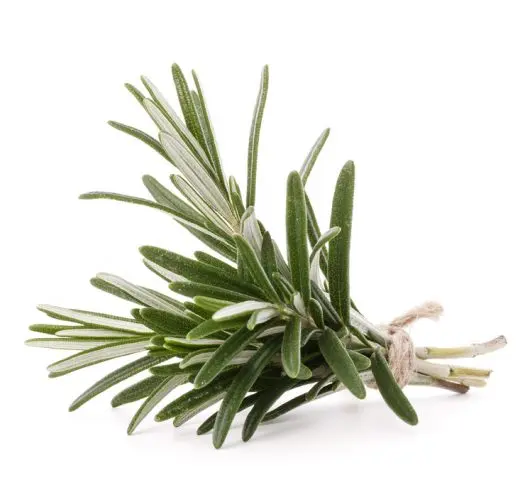
What does rosemary seasoning look like + photo
Rosemary is a perennial, highly branched subshrub of the Lamiaceae family with evergreen leaves, which under natural conditions can reach 2 m in height.
Rosemary leaves have an elongated, lanceolate shape of a bright green hue. To the touch, they are quite dense, have a glossy outer surface. On the underside, they are matte-pubescent and have a lighter shade. Rosemary blooms in various shades of blue and pale purple. Seeds are small, elongated, brown.
As a seasoning, only leaves are used, sometimes whole small branches, abundantly covered with leaves. For the manufacture of spices, the youngest and most tender leaves are collected from the top 1/3 of the branches before flowering. The collection of leaves should be carried out no earlier than the plant is 3-4 years old. With proper drying, the leaves roll up into thin tube sticks, which most of all resemble small needles with a convex upper surface and a folded lower surface. It is in this form that rosemary seasoning (pictured below) appears in its traditional dried form, ready for use.
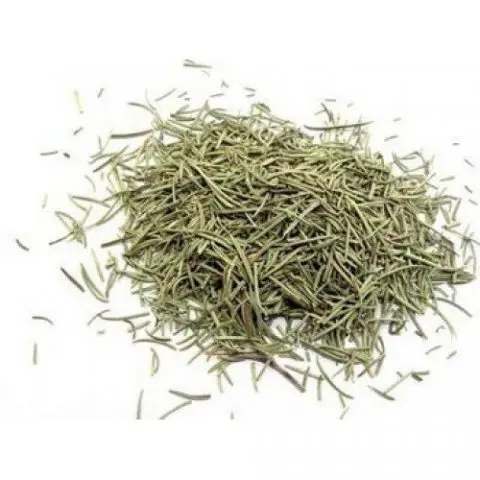
However, rosemary has become more and more popular in recent years. Therefore, it is often used fresh, bought on the market or growing on the kitchen windowsill, and even frozen, harvested independently in the summer season.
Also, ready-made dried rosemary seasoning is easy to purchase at almost any grocery store or market.
What does rosemary smell like?
Rosemary is not in vain translated from Latin as “sea dew” or “sea freshness”. Its aroma is really very fresh, pleasant, slightly sweet. It harmoniously combines notes of citrus, camphor, eucalyptus against the background of resinous conifers, primarily pine.
The taste of the seasoning is quite burning and somewhat bitter, so it should be used in very moderate proportions. When dried, the leaves of the seasoning practically do not smell. To feel their aroma, the spice must be lightly rubbed between the fingers or in the palm of your hand. The aroma of rosemary is also enhanced during heat treatment, and it does not weaken, so the spice can be completely added at the beginning of cooking.
The greatest value in the plant is the essential oil, which in itself contains many useful substances, primarily for mental activity. It is actively used for medical purposes, and in perfumery, and cosmetics.
In addition, the rosemary aroma itself can have a beneficial effect on the human body.
- Improves mood, restores strength and desire to live, especially after stress and trouble.
- Helps to gain determination, activates forces and forces to act.
- Tones, adjusts in a positive way.
- Helps increase mental activity, improve memory.
- Has aphrodisiac properties.
Where is rosemary added?
Since the Mediterranean countries are considered the birthplace of rosemary, it is not surprising that it is most often added to Italian, Greek and French cuisine.
Rosemary can be used both as an independent seasoning and as one of the components of a mixture of fragrant spices. The most famous ready-made spicy compositions with rosemary:
- Provencal herbs;
- bouquet Garni;
- Italian herbs.
However, in recent decades, the use of rosemary has been noticed not only in European, but even in Asian cuisines.
Historically, this seasoning has been actively used to make a variety of meat dishes, especially wild game. After all, rosemary beats off the unpleasant aroma characteristic of many varieties of meat, and also contributes to the digestion of food that is relatively heavy for the stomach. In modern cuisines, almost any meat dish (from pork, lamb, rabbit meat) is complete without the addition of rosemary. It is only important not to exceed the dosage, otherwise you can achieve the opposite effect – the meat may begin to taste slightly bitter.

Usually rosemary is added to marinades when soaking various types of meat. But it can be added to meat dishes and when stewing, and when cooking, and in the manufacture of goulash or minced meat.
An indispensable seasoning is also used for cooking meat and fish dishes, grilled or baked on charcoal. With dried rosemary, you can not only rub the prepared dish, but also sprinkle embers with it. So that the aroma from them flavored fried meat. In the Mediterranean countries, dry sprigs of rosemary are even used as natural fragrant skewers or skewers. It is believed that its aroma drives away evil spirits, and the substances contained in the essential oil reduce the harmful effects of carcinogens on the human body.
Seasoning can also give a delicious aroma and improve the taste of baked, stewed or fried poultry: chicken, duck, turkey.
The second popular use of rosemary in cooking is as an addition to cheese dishes. Seasoning can be used both at the time of making cheese, and already as a flavoring additive for finished culinary products.
This seasoning is no less good in a variety of dishes with mushrooms and eggs.
However, all kinds of vegetables – potatoes, beans, eggplant, any kind of cabbage, tomatoes, zucchini, will only benefit from the addition of rosemary in the process of their preparation. For example, in the manufacture of sun-dried tomatoes, which is gaining popularity, it is the addition of this seasoning that plays a decisive role in shaping the taste of the dish.
You can also recall the classic Greek dish of baked zucchini, eggplant, tomatoes and onions with garlic, the taste of which is greatly improved by the addition of rosemary.
And in Our Country, fried in olive oil or baked potatoes with sea salt and sprigs of thyme and rosemary are becoming more and more popular.
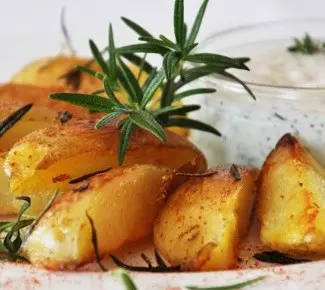
The use of affordable Crimean rosemary as an additive to all kinds of sauces and gravies is becoming a good tradition. This spice is able to ennoble the taste of any vinegar. Any vegetable oil infused with rosemary is very tasty and fragrant. Combined with garlic, lemon zest and capers, it makes a tempting addition to any meat or fish sauce.
By the way, it is in the manufacture of fish that rosemary seasoning should be used very carefully. It is necessary to add it in minimal quantities and preferably at the end of the cooking process, otherwise the taste of the finished dish may be thoroughly spoiled. Due to the rather active aroma, this spice should be used with caution in dishes with subtle flavors, so as not to interrupt their smell and taste.
Finally, we should especially note the good compatibility of rosemary with pasta, pastries, confectionery and sweet products. It is customary to add it to the dough during baking, sprinkle finished products with dry ground powder. The seasoning gives a special aroma and taste to some fruit desserts, salads and jellies.
Where do you put rosemary when canning?
Due to the good preservative properties of rosemary, this seasoning is often used when preparing stocks for the winter.
The addition of rosemary during pickling, salting and pickling of cabbage and other vegetables not only increases the safety of the preparations, but also improves their taste, making them even more useful and attractive.
The addition of rosemary will help to give the blanks additional piquancy and improve their aroma when pickling and pickling mushrooms.
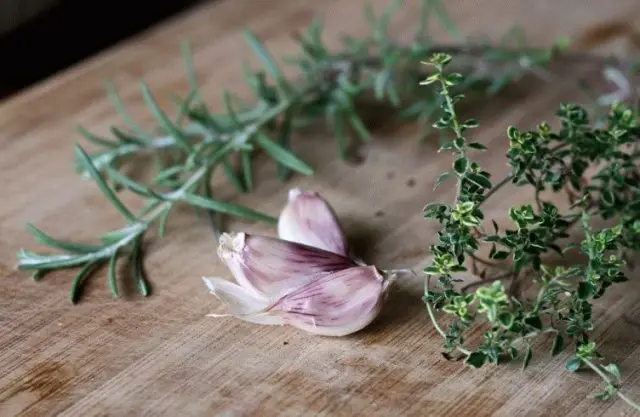
It should only be borne in mind that for fermentation and salting it is desirable to use fresh twigs and leaves of the plant if possible. But for marinades, especially where hot filling is used, dried rosemary is added.
The use of rosemary in the preparation of alcoholic and non-alcoholic beverages
Since ancient times, the famous rosemary honey and the equally famous rosemary wine have been used for healing. The latter was prepared by steeping fresh rosemary leaves in light dry or semi-dry grape wine for several days.
Currently, the most famous alcoholic drink using rosemary is vermouth. Seasoning is also used to prepare various medicinal tinctures for alcohol or vodka, including those with the addition of other aromatic herbs. Rosemary is able to simply ennoble the taste and aroma of almost any alcohol-containing drink: liquor, punch, grog, mulled wine, beer.
In the homeland of the plant, in Italy and France, this seasoning is added even when cooking compotes and jelly.
Known recipe for the famous medicinal tea with rosemary.
You need:
- 1 tsp topped with crushed dry rosemary leaves;
- 250 ml boiling water.
Manufacture:
- Rosemary leaves are poured into boiling water.
- Insist under the lid for 15 minutes.
Use one cup 2 times a day during infectious diseases or during epidemics to strengthen immunity.
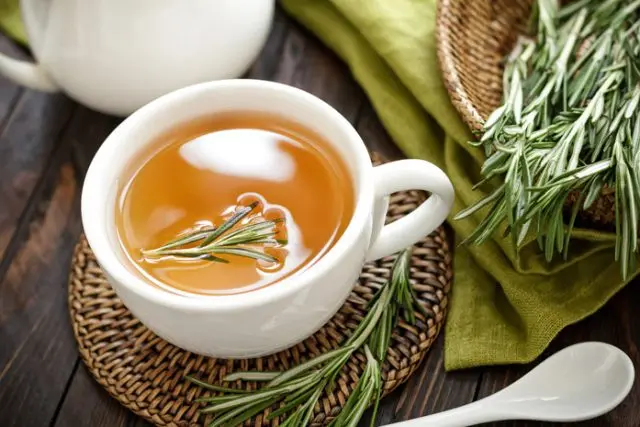
Rosemary is also a very popular additive in the manufacture of non-alcoholic cocktails, lemonades and other soft drinks.
How to prepare rosemary for the winter
In the old days, harvesting rosemary for the winter was limited solely to drying its leaves. Nowadays, there are a wide variety of interesting ways to preserve the taste, aroma and beneficial properties of this seasoning throughout the year.
Can rosemary be frozen?
With the advent of modern freezers, freezing rosemary has become the most popular and interesting way to preserve rosemary for the winter. Moreover, often in the end you can get a real ready-made seasoning that will help not only enrich the taste of the dish, but also provide it with additional useful elements.
Freezing with oils
In this way, you can prepare for the winter not only rosemary separately, but also mixed with any other herbs.
- The grass is washed, dried, finely cut and laid out in any small containers for freezing. It is better to use silicone molds for easier extraction.
- Forms are filled in half or even a large part of them.
- If butter is used for pouring, then it is first melted on the stove, and then, after cooling a little, rosemary leaves are poured into molds.
- Pour the contents of the molds immediately with olive or other vegetable oil.
- After the oil has completely cooled, the containers are removed from the freezer.
When using this method, the leaves retain all their taste, aroma, as well as beneficial properties, which are still partially transferred to oils and enhanced by them.
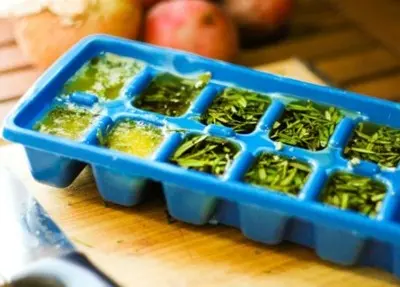
If there are not enough convenient molds for freezing, then this method can be slightly improved. An oil-herbal mixture is prepared, ground ginger, garlic or lemon zest are added to it and everything is ground in a blender until a homogeneous paste is obtained. The resulting paste can be placed in a plastic bag with a zipper, straightened in a horizontal position, closed and put in the freezer.
Rosemary, harvested for the winter in this way, can be seasoned with pasta, pie filling, stewed and fried potatoes and any other vegetables, as well as meat products.
Normal freezing
Rosemary, after washing and drying, is crushed with a knife and, spread out on a thin pallet, removed for 12-24 hours in the freezer.
After the allotted time, the grass is taken out, transferred to a plastic container or a plastic bag, labeled to remember and put back in the freezer.
By the way, rosemary greens can also be stored frozen in ice cubes. This storage method is convenient for later adding them to a variety of drinks and liquid dishes, such as soups and stews.
The fastest and easiest way to freeze
This method is especially useful if you want to save a large amount of rosemary.
- Shrub branches, along with leaves, are thoroughly washed in cold water.
- Dry at room temperature until complete evaporation of moisture.
- Directly as a whole, they are placed in plastic bags with a zipper, closed and placed in the freezer for several days.
- After a few days, completely frozen packages are pulled out and, without opening them, they are placed on the table and rolled on top with a wooden rolling pin.
- The leaves are very good and easy to separate from the stems, while remaining completely fresh and green.
- After that, if desired, the stems can be easily separated from the leaves, and the latter can be put back into storage in the freezer.
In this form, rosemary retains both a fresh green look and all its aromatic and gustatory properties, and can be used to prepare absolutely any dishes and drinks.
How to dry rosemary
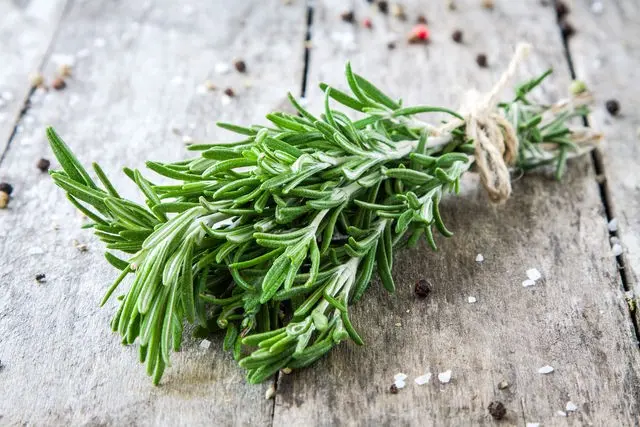
Drying rosemary is easy. Usually it is divided into bunches of small sizes and, tied with a strong thread, hung in a warm, shady, dry, but ventilated place for several days. If a dryer is available, then you can dry the seasoning in it. You should only know that the drying temperature should not exceed + 35 ° C.
Then the branches are placed in a tight plastic bag, close it and rub the dried greens in it with your hands. As a result, the leaves are separated from the stems and they can be laid out in hermetically sealed packages.
How to store rosemary as salt
There is another way to preserve rosemary for the winter, traditionally used in the Mediterranean countries.
- Rosemary leaves are separated from the stems and mixed with sea salt. The number of leaves collected from 10 stems will require about 80 g of salt.
- The mixture is interrupted with a blender until it turns greenish.
- Spread the mixture in a thin layer on a baking sheet covered with baking paper.
- Dry in the oven at a temperature of about 100 ° C for 15-20 minutes.
- Lay out in absolutely dry and clean jars, tightly close and store in a dark and dry place.
The fragrant and tasty salt resulting from these actions can serve as a seasoning for salads and many other dishes, including savory pastries.
How to store rosemary (fresh and dried storage rules)
Of course, at the height of summer, you want to make the most of fresh rosemary greens for cooking various dishes. Keeping it fresh for 1 month is easy. To do this, it is only necessary to comply with two basic conditions: low temperature (about + 5 ° C) and high humidity.
- The easiest way is to put the branches in a jar of water, cover with plastic and refrigerate. It is advisable to change the water in the bank every day.
- You can leave such a jar in the conditions of the room. In this case, it is likely that some branches will even be able to take root and the bush can be transplanted into the land mixture.
- You can wrap rosemary sprigs in parchment paper or a damp cloth, place in a bag or transparent container, and store in the refrigerator for about a month.
In vacuum bags, such greens can be stored in a refrigerator for up to 3 months inclusive.
Frozen rosemary can be stored for 6 to 8 months without losing its flavor properties.

In dried form, this seasoning can be stored in a dry place without access to light for about six months.
In the form of a flavored salt, rosemary retains its properties for up to 12 months.
Conclusion
Rosemary seasoning can be added to such an endless number of dishes that it can rightfully be considered universal. From the first time, perhaps not everyone will be able to appreciate its taste and aroma. With regular use, you can get so used to the new look of familiar dishes that it will be difficult to do without it later. It is only important to observe the required dosage.









